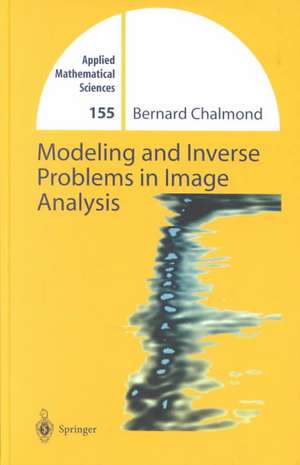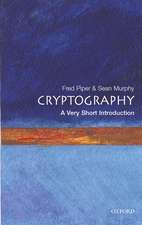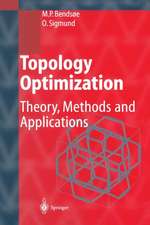Modeling and Inverse Problems in Imaging Analysis: Applied Mathematical Sciences, cartea 155
Autor Bernard Chalmond Traducere de Kari A. Fosteren Limba Engleză Hardback – 14 ian 2003
| Toate formatele și edițiile | Preț | Express |
|---|---|---|
| Paperback (1) | 390.63 lei 6-8 săpt. | |
| Springer – 12 dec 2011 | 390.63 lei 6-8 săpt. | |
| Hardback (1) | 396.02 lei 6-8 săpt. | |
| Springer – 14 ian 2003 | 396.02 lei 6-8 săpt. |
Din seria Applied Mathematical Sciences
- 13%
 Preț: 426.94 lei
Preț: 426.94 lei - 13%
 Preț: 426.46 lei
Preț: 426.46 lei - 13%
 Preț: 427.63 lei
Preț: 427.63 lei - 9%
 Preț: 1728.55 lei
Preț: 1728.55 lei - 24%
 Preț: 906.78 lei
Preț: 906.78 lei - 23%
 Preț: 659.05 lei
Preț: 659.05 lei -
 Preț: 375.64 lei
Preț: 375.64 lei - 18%
 Preț: 909.47 lei
Preț: 909.47 lei - 18%
 Preț: 795.02 lei
Preț: 795.02 lei - 18%
 Preț: 950.52 lei
Preț: 950.52 lei - 15%
 Preț: 645.47 lei
Preț: 645.47 lei - 20%
 Preț: 755.46 lei
Preț: 755.46 lei -
 Preț: 382.65 lei
Preț: 382.65 lei - 24%
 Preț: 808.03 lei
Preț: 808.03 lei -
 Preț: 452.62 lei
Preț: 452.62 lei -
 Preț: 190.23 lei
Preț: 190.23 lei -
 Preț: 399.12 lei
Preț: 399.12 lei - 18%
 Preț: 966.90 lei
Preț: 966.90 lei - 15%
 Preț: 643.48 lei
Preț: 643.48 lei - 15%
 Preț: 528.80 lei
Preț: 528.80 lei -
 Preț: 413.15 lei
Preț: 413.15 lei -
 Preț: 390.25 lei
Preț: 390.25 lei - 18%
 Preț: 736.01 lei
Preț: 736.01 lei - 18%
 Preț: 1411.05 lei
Preț: 1411.05 lei - 15%
 Preț: 711.21 lei
Preț: 711.21 lei -
 Preț: 395.47 lei
Preț: 395.47 lei - 18%
 Preț: 1017.26 lei
Preț: 1017.26 lei -
 Preț: 403.15 lei
Preț: 403.15 lei - 18%
 Preț: 1130.14 lei
Preț: 1130.14 lei - 18%
 Preț: 1134.87 lei
Preț: 1134.87 lei - 18%
 Preț: 1329.00 lei
Preț: 1329.00 lei - 18%
 Preț: 1129.65 lei
Preț: 1129.65 lei - 18%
 Preț: 1140.71 lei
Preț: 1140.71 lei
Preț: 396.02 lei
Nou
Puncte Express: 594
Preț estimativ în valută:
75.78€ • 79.33$ • 62.70£
75.78€ • 79.33$ • 62.70£
Carte tipărită la comandă
Livrare economică 05-19 aprilie
Preluare comenzi: 021 569.72.76
Specificații
ISBN-13: 9780387955476
ISBN-10: 038795547X
Pagini: 314
Ilustrații: XXII, 314 p.
Dimensiuni: 155 x 235 x 21 mm
Greutate: 0.6 kg
Ediția:2003
Editura: Springer
Colecția Springer
Seria Applied Mathematical Sciences
Locul publicării:New York, NY, United States
ISBN-10: 038795547X
Pagini: 314
Ilustrații: XXII, 314 p.
Dimensiuni: 155 x 235 x 21 mm
Greutate: 0.6 kg
Ediția:2003
Editura: Springer
Colecția Springer
Seria Applied Mathematical Sciences
Locul publicării:New York, NY, United States
Public țintă
ResearchCuprins
1 Introduction.- 1.1 About Modeling.- 1.2 Structure of the Book.- I Spline Models.- 2 Nonparametric Spline Models.- 3 Parametric Spline Models.- 4 Auto-Associative Models.- II Markov Models.- 5 Fundamental Aspects.- 6 Bayesian Estimation.- 7 Simulation and Optimization.- 8 Parameter Estimation.- III Modeling in Action.- 9 Model-Building.- 10 Degradation in Imaging.- 11 Detection of Filamentary Entities.- 12 Reconstruction and Projections.- 13 Matching.- References.- Author Index.
Recenzii
From the reviews:
"...This book is an excellent introduction to Bayesian imaging and spline models in image analysis. It can be used for courses aimed at both mathematical statisticians who want to learn more about applications to imaging and engineers who aim to incorporate adequate mathematical formalism into their research."-- MATHEMATICAL REVIEWS
"The introduction of this book clearly explains – at a level any undergraduate student in mathematics can understand – the basic concepts of image analysis. The examples throughout the book are well-explained and rich. The different types of modeling are also explained … . this book can be advised to students or beginning researchers who want to have a good overview with an easy, self-contained introduction to the field of Image Analysis." (Peter Leoni, Physicalia, Vol. 28 (4-6), 2006)
"...This book is an excellent introduction to Bayesian imaging and spline models in image analysis. It can be used for courses aimed at both mathematical statisticians who want to learn more about applications to imaging and engineers who aim to incorporate adequate mathematical formalism into their research."-- MATHEMATICAL REVIEWS
"The introduction of this book clearly explains – at a level any undergraduate student in mathematics can understand – the basic concepts of image analysis. The examples throughout the book are well-explained and rich. The different types of modeling are also explained … . this book can be advised to students or beginning researchers who want to have a good overview with an easy, self-contained introduction to the field of Image Analysis." (Peter Leoni, Physicalia, Vol. 28 (4-6), 2006)
Textul de pe ultima copertă
More mathematics have been taking part in the development of digital image processing as a science, and the contributions are reflected in the increasingly important role modeling has played solving complex problems. This book is mostly concerned with energy-based models. Through concrete image analysis problems, the author develops consistent modeling, a know-how generally hidden in the proposed solutions.
The book is divided into three main parts. The first two parts describe the theory behind the applications that are presented in the third part. These materials include splines (variational approach, regression spline, spline in high dimension) and random fields (Markovian field, parametric estimation, stochastic and deterministic optimization, continuous Gaussian field). Most of these applications come from industrial projects in which the author was involved in robot vision and radiography: tracking 3-D lines, radiographic image processing, 3-D reconstruction and tomography, matching and deformation learning. Numerous graphical illustrations accompany the text showing the performance of the proposed models.
This book will be useful to researchers and graduate students in mathematics, physics, computer science, and engineering.
The book is divided into three main parts. The first two parts describe the theory behind the applications that are presented in the third part. These materials include splines (variational approach, regression spline, spline in high dimension) and random fields (Markovian field, parametric estimation, stochastic and deterministic optimization, continuous Gaussian field). Most of these applications come from industrial projects in which the author was involved in robot vision and radiography: tracking 3-D lines, radiographic image processing, 3-D reconstruction and tomography, matching and deformation learning. Numerous graphical illustrations accompany the text showing the performance of the proposed models.
This book will be useful to researchers and graduate students in mathematics, physics, computer science, and engineering.














